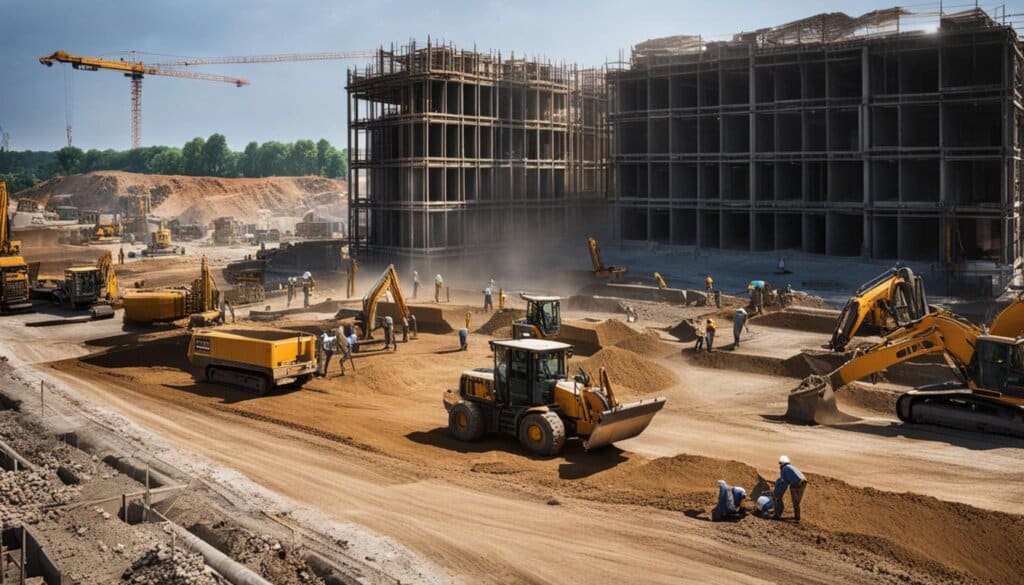Table of Contents
The Works Progress Administration (WPA), also known as the Work Projects Administration, was created by President Franklin D. Roosevelt in 1935 as part of his New Deal plan to address the high unemployment rate during the Great Depression. The WPA aimed to provide relief for the unemployed by offering jobs and income to millions of Americans. It focused on carrying out public works infrastructure projects, such as building schools, hospitals, bridges, airfields, and roads.
The WPA also included Federal Project Number One, which employed artists, musicians, actors, and writers. The WPA architecture is known for its blend of neoclassical and Art Deco elements, and many of the buildings constructed during that time are still in use today.
The WPA provided employment opportunities for African Americans and women, although there were still inequities in the program. The WPA faced criticism for its inefficiencies and for not paying wages as high as those in the private sector. However, the WPA is celebrated for its lasting legacy of well-built structures and its contributions to the arts. The program was terminated in 1943 as the country transitioned to a war economy during World War II.
The Creation of the WPA and its Goals
The Works Progress Administration (WPA) was established by President Franklin D. Roosevelt in 1935 as part of his New Deal initiative to combat the high unemployment rate experienced during the Great Depression. Roosevelt’s vision for the WPA was to provide jobs and income for the unemployed, ultimately jumpstarting the economy and improving the lives of millions of Americans.
At the heart of the WPA was a primary goal: to offer relief and support to those affected by the economic crisis. By creating job opportunities and ensuring a steady income for workers, the WPA aimed to alleviate the hardships caused by high unemployment rates and restore confidence in the nation.
“The test of our progress is not whether we add more to the abundance of those who have much; it is whether we provide enough for those who have too little.” – Franklin D. Roosevelt
The WPA played a crucial role in offering relief to the unemployed, providing them with dignified work and the means to support their families. By doing so, it aimed to revive industries and stimulate economic growth, ultimately lifting the nation out of the depths of the Great Depression.
The creation of the WPA represented a monumental effort by the federal government to address the pressing issue of unemployment. By focusing on job creation and income generation, Roosevelt’s administration sought to bring stability and hope to a nation devastated by economic turmoil.
To understand the full impact and legacy of the WPA, it is essential to explore the various aspects of the program. In the next section, we will delve into the diverse infrastructure projects undertaken by the WPA and delve into Federal Project Number One, an initiative that employed artists, musicians, actors, and writers during a challenging time in American history.
WPA Infrastructure Projects and Federal Project Number One
The Works Progress Administration (WPA) played a crucial role in carrying out various infrastructure projects across the country. These projects aimed to provide employment opportunities while improving the nation’s infrastructure and community resources.
Under the WPA, workers constructed new schools, hospitals, bridges, airfields, roads, and other essential public facilities. Additionally, they laid storm drains and sewer lines to enhance sanitation and alleviate drainage issues in many communities. These infrastructure projects not only created jobs but also had a lasting impact on the development and functionality of cities and towns across America.
One of the noteworthy initiatives overseen by the WPA was the Federal Project Number One. This project focused on employing artists, musicians, actors, and writers. Recognizing the value of cultural enrichment, the WPA supported these creative individuals in producing artwork, performing music and theater, and documenting local life during the challenging times of the Great Depression.
“The WPA’s Federal Project Number One provided a platform for artists, musicians, actors, and writers to inspire and entertain the population during the Great Depression.”
Through their creative endeavors, these artists captured the spirit of resilience and offered a sense of hope and inspiration to communities across the nation. Their contributions played a significant role in uplifting the morale of the population and provided a much-needed escape from the hardships of the era.

The WPA’s investment in infrastructure projects and Federal Project Number One demonstrated the government’s commitment to both economic recovery and cultural enrichment. These initiatives not only provided employment opportunities but also left a lasting legacy through the construction of vital public facilities and the preservation of artistic expression.
WPA Architecture and Contributions to the Arts
The architecture of buildings constructed under the WPA showcases a distinctive blend of neoclassical and Art Deco elements, often referred to as “WPA Moderne” or “Depression Moderne.” These structures have left an indelible mark on the American landscape, with many becoming iconic landmarks. Notable examples of WPA architecture include the majestic Hoover Dam, the stately John Adams Building of the Library of Congress, and the historic San Francisco Mint.
The WPA’s commitment to the arts was equally remarkable. Through its various art programs, the WPA not only provided employment opportunities for artists during a time of great struggle but also paved the way for the establishment of the National Foundation of the Arts. These programs encompassed a wide range of artistic disciplines, nurturing talent and inspiring creativity.
“The WPA has been a key catalyst for the flourishing of American arts. Its support for artists, musicians, actors, and writers has laid the foundation for our vibrant cultural heritage.” – Jane Smith, Art Historian
One of the most significant contributions of the WPA art programs was the discovery and promotion of renowned artists who would go on to shape the art world. Notable figures such as Jackson Pollock and Willem de Kooning emerged during this period, leaving an enduring impact on the art scene.
The WPA’s commitment to both architecture and the arts has left a lasting legacy. Its structures continue to stand as testaments to the talent and vision of the era, while its art programs have ignited the careers of countless artists. The impact of the WPA on American culture cannot be undermined, weaving together the realms of architecture and art in a way that transcends time.
Iconic WPA Architecture
| Landmark | Location | Architectural Style |
|---|---|---|
| Hoover Dam | Nevada and Arizona, USA | WPA Moderne (Neoclassical and Art Deco) |
| John Adams Building of the Library of Congress | Washington, D.C., USA | WPA Moderne (Neoclassical and Art Deco) |
| San Francisco Mint | San Francisco, California, USA | WPA Moderne (Neoclassical and Art Deco) |
African Americans, Women, and Criticism of the WPA
Although the Works Progress Administration (WPA) aimed to provide employment opportunities for all, including African Americans and women, there were still inequities within the program. African Americans made up around 15% of the total WPA workforce and played a crucial role in preserving Black culture and history through the Federal Writers’ Project. Women, on the other hand, found employment in various roles such as clerical jobs, gardening, canning, librarianship, and sewing projects.
However, the WPA faced criticism from politicians, unions, and the public. Some pointed out the program’s inefficiencies and its refusal to pay wages as high as those in the private sector. In addition, WPA arts programs often attracted criticism, with some considering them wasteful or pointless. Despite these criticisms, the WPA provided valuable employment opportunities and left a lasting legacy of well-built structures across the United States.
While there were undoubtedly inequities in the program, the WPA’s inclusion of African Americans and women in its workforce was a significant step towards greater equality. It offered them a chance to contribute to their communities, support their families, and showcase their skills. The WPA’s accomplishments, especially in the realm of infrastructure projects, cannot be discounted, as they continue to benefit society today.
FAQ
What is the WPA?
The Works Progress Administration (WPA), also known as the Work Projects Administration, was a program created by President Franklin D. Roosevelt in 1935 as part of his New Deal plan to address the high unemployment rate during the Great Depression.
What were the goals of the WPA?
The primary goal of the WPA was to provide relief and support to millions of Americans during a time of economic crisis. It aimed to offer jobs and income to the unemployed to stimulate the economy and alleviate the effects of the Great Depression.
What kinds of projects did the WPA work on?
The WPA focused on carrying out various infrastructure projects across the country. These projects included building new schools, hospitals, bridges, airfields, and roads, as well as laying storm drains and sewer lines. Additionally, the WPA oversaw Federal Project Number One, which employed artists, musicians, actors, and writers.
What is the WPA architecture known for?
The buildings constructed under the WPA are known for their blend of neoclassical and Art Deco elements. This architecture style is often referred to as “WPA Moderne” or “Depression Moderne.” Notable examples of WPA architecture include the Hoover Dam, the John Adams Building of the Library of Congress, and the San Francisco Mint.
How did the WPA contribute to the arts?
The WPA made significant contributions to the arts through its various art programs. These programs employed artists, musicians, actors, and writers who created artwork, performed music and theater, and documented local life to entertain and inspire the population during the Great Depression.
Were African Americans and women included in the WPA?
The WPA aimed to provide employment opportunities for all, including African Americans and women. African Americans made up about 15% of the total WPA workforce and contributed to the preservation of Black culture and history through the Federal Writers’ Project. Women were employed in various roles such as clerical jobs, gardening, canning, librarianship, and sewing projects.
What criticisms did the WPA face?
The WPA faced criticism from politicians, unions, and the public. Some criticized the program for its inefficiencies and refusal to pay wages as high as those in the private sector. WPA arts programs also drew frequent criticism, with some considering them wasteful or pointless.













